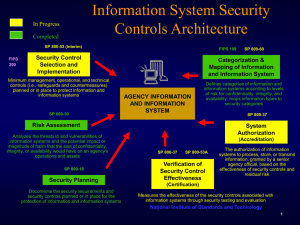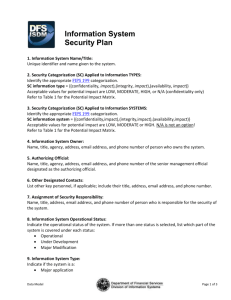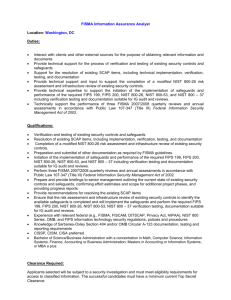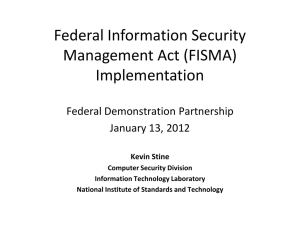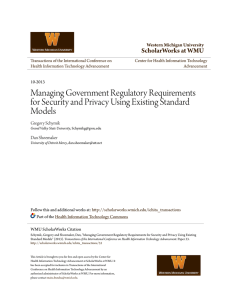Federal Information Security Management Act (FISMA)
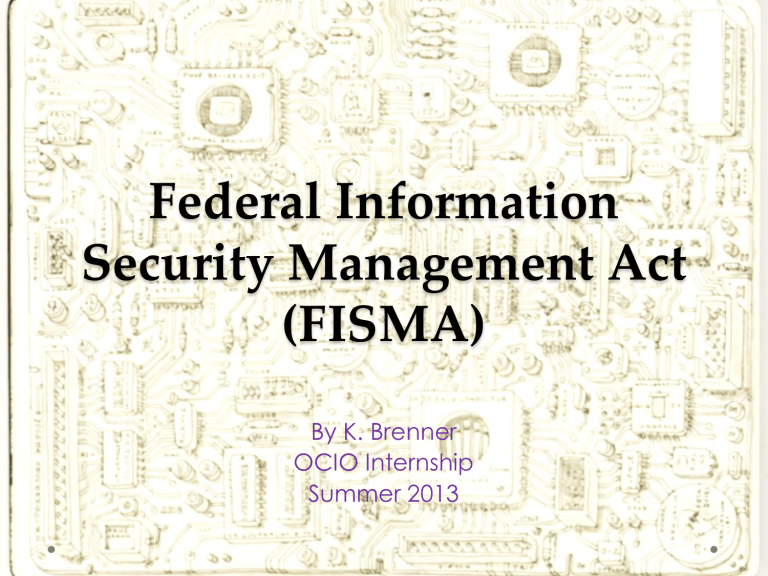
Federal Information
Security Management Act
(FISMA)
By K. Brenner
OCIO Internship
Summer 2013
FISMA Legislation
Overview
“Each federal agency shall develop, document, and implement an agency-wide information security program to provide information security for the information and information systems that support the operations and assets of the agency, including those provided or managed by another agency, contractor, or other source…”
-Federal Information Security Management Act of 2002
National Institute of Standards and Technology
2
Information Security
Program
Links in the Security Chain: Management, Operational, and Technical Controls
Risk assessment
Security planning
Security policies and procedures
Contingency planning
Incident response planning
Security awareness and training
Physical security
Personnel security
Certification, accreditation, and security assessments
Access control mechanisms
Identification & authentication mechanisms
(Biometrics, tokens, passwords)
Audit mechanisms
Encryption mechanisms
Firewalls and network security mechanisms
Intrusion detection systems
Security configuration settings
Anti-viral software
Smart cards
Adversaries attack the weakest link…where is yours?
NIST
USGCB
A Closer Look
NIST
FISMA
OMB Audits
(Scorecard)
DOD DISA
DHS
NVDB
Managing Enterprise Risk
The Framework
SP 800-53 / FIPS 200
Security Control
Selection
Selects minimum security controls (i.e., safeguards and countermeasures) planned or in place to protect the information system
FIPS 199 / SP 800-60
Starting Point
Security
Categorization
Defines category of information system according to potential impact of loss
SP 800-37
Security Control
Monitoring
Continuously tracks changes to the information system that may affect security controls and assesses control effectiveness
SP 800-53 / FIPS 200 / SP 800-30
Security Control
Refinement
Uses risk assessment to adjust minimum control set based on local conditions, required threat coverage, and specific agency requirements
SP 800-37
System
Authorization
Determines risk to agency operations, agency assets, or individuals and, if acceptable, authorizes information system processing
SP 800-18
Security Control
Documentation
In system security plan, provides a an overview of the security requirements for the information system and documents the security controls planned or in place
SP 800-53A / SP 800-37
SP 800-70
Security Control
Implementation
Implements security controls in new or legacy information systems; implements security configuration checklists
Security Control
Assessment
Determines extent to which the security controls are implemented correctly, operating as intended, and producing desired outcome with respect to meeting security requirements
National Institute of Standards and Technology
5
SysOps Process
Risk
Management
(Baseline of
Security
Controls)
Document
(Change
Request)
Implement
(Test Server)
Authorize
(Review Board )
Monitor
[Responsible]
(tools)
United States Department of Treasury’s
Departmental Offices Monthly Security Updates Program
Server(s) Classification
Security Categorization
Example: An Enterprise Information System
FIPS Publication
199
Low Moderate High
Guidance for
Mapping Types of
Information and
Information
Systems to FIPS
Publication 199
Security
Categories
SP 800-60
Confidentiality
Integrity
Availability
The loss of confidentiality could be expected to have a limited adverse effect on organizational operations, organizational assets, or individuals.
The loss of confidentiality could be expected to have a serious adverse effect on organizational operations, organizational assets, or individuals.
The loss of integrity could be expected to have a limited adverse effect on organizational operations, organizational assets, or individuals.
The loss of availability could be expected to have a limited adverse effect on organizational operations, organizational assets, or individuals.
The loss of integrity could be expected to have a serious adverse effect on organizational operations, organizational assets, or individuals.
The loss of availability could be expected to have a serious adverse effect on organizational operations, organizational assets, or individuals.
The loss of confidentiality could be expected to have a severe or catastrophic adverse effect on organizational operations, organizational assets, or individuals.
The loss of integrity could be expected to have a severe or catastrophic adverse effect on organizational operations, organizational assets, or individuals.
The loss of availability could be expected to have a severe or catastrophic adverse effect on organizational operations, organizational assets, or individuals.
WORKS CITED
•
• NIST. Computer Security Resource Center. Federal
Information Security Management Act (FISMA)
Implementation Project. N.p., n.d. Web. 27 June
2013. <http://www.nist.gov/itl/csd/soi/fisma.cfm>.
